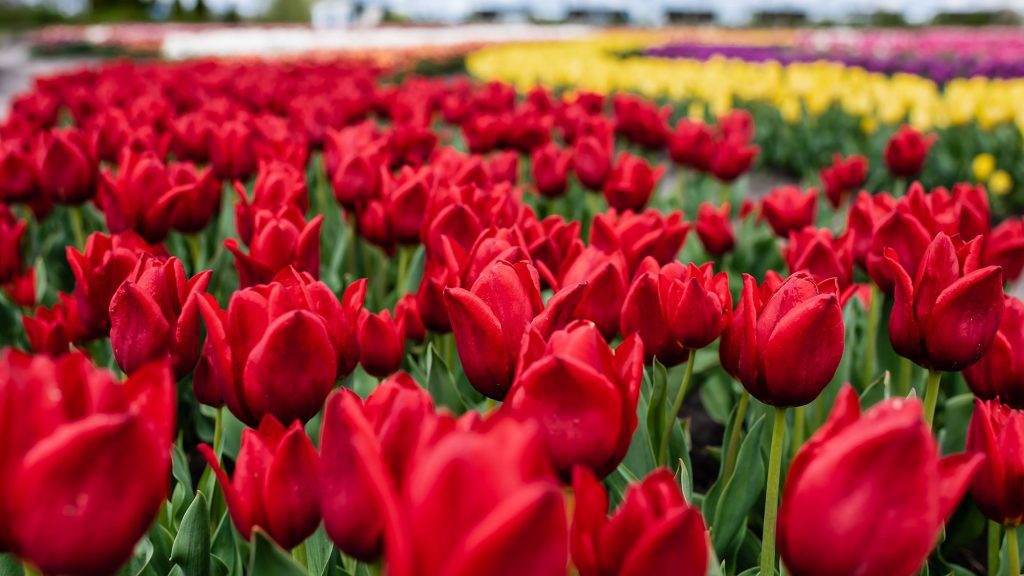Starting in early March, several large, futuristic white machines began moving through farmland in The Netherlands. At first, they look like a mix between a tractor and a World War I-era track-based tank, but with a shiny sci-fi look. These machines are fully autonomous and AI enabled. agriculture robots that are responsible for finding and getting rid of diseased tulip bulbs before the country’s important Spring tulip bloom. This robot, made in the Netherlands, is just one of many new autonomous tools that are quickly being introduced on farms and and ranches worldwide.
How does the robot detect infected tulips?
The tulip-spotting robot, designed by the Netherlands based company H2L Robotics, is officially known as “Selector180.” It weighs in at about 2,600 pounds, and it uses GPS coordinates to self-drive through tulip fields and onboard cameras to take thousands of photos. An AI model then looks through these images for signs of potentially diseased bulbs, which are often recognized by distinct red stripes on the bulb’s leaves. The Selector machine then selects the diseased bulbs and separates them from the others to stop the disease from spreading. H2L describes the machine as the “world’s first autonomous tulip selection robot.” A video below shows the Selector in action sorting through a row of bulbs.
Speaking with PopSci, H2L Robotics Managing Director Erik de Jong said the Selector’s AI models were trained using the knowledge of specialized tulip farmers, known in the industry as “sickness’s spotter” who previously carried out the laborious inspections by hand. H2L would show these spotters images of firms and they would point out bulbs with signs of thes virus. These observations then helped train the model powering the Selector. As more farmers participated, the Selector’s ability to accurately spot the virus improved. The machine, Dr. Jong said, benefited from a “wisdom of crowds.”
Machines like H2L’s will become increasingly important in the coming years, de Jong added, because now aging human sports are “basically becoming extinct.”
“Usually these are old individuals who have been spotting sick tulips for decades,” de Jong said. “There just are not that many of them any more so it is becoming a real problem.”
Around a million winter-weary tourists visit the Netherlands annually to see the colorful blooming tulips. The season begins in March and peaks around the middle of April. If left unchecked, diseased tulip buds can result in smaller and weaker bulbs. Eventually, it can even lead to bulbs that are unable to flower at all.
[Related: How John Deere’s tech evolved from 19th-century plows to AI and autonomy]
For Dutch farmers, tulips aren’t just pretty to look at. They are a big business. The Netherlands is consistently the world’s top tulip exporter and reportedly exported €81.9 million (or $88.78 million USD) worth of flowers outside the European Union in 2022. as per The Brussels Times. About 800 different types of tulips are planted and can bloom in bright reds, oranges, and yellow rows. The extensive and colorful fields can even be seen from NASA satellites in space.
H2L robotics was established in 2019 and sent its first robot to farmers in February 2021. Before the introduction of the Selector, virus identification was reportedly done by human “sickness spotters.” The robots, which reportedly cost around $200,000 each, can work long hours without rest and potentially cover more area faster than a human counterpart. Currently, H2L has sold 62 Selector machines, 55 of which are in operation.
“We've always sold these machines with the commitment that it will achieve about the performance of a human,” de Jong said. “We've never tried to oversell it.”
AI tools are aiding farmers in increasing harvest yields and exploring sustainability
Farmers and agricultural startups around the world have been exploring computer vision and machine learning algorithms to enhance harvests and reduce costs long before generative AI tools like ChatGPT and DALL-E were widely known. In addition to autonomous robots, large-scale farmers are increasingly relying on a combination of drones, satellite imagery, and remote sensors to help in identifying diseases or potentially dangerous chemicals. In other places, farmers are using AI to sift through weather and other environmental data in an attempt to advocate for more sustainable farming methods and optimize planting schedules. de Jong, from H2L Robotics, states that systems similar to the Selector robot could one day be used to detect illness or irregularities in other crops like potatoes or onions.
However, robots like the ones deployed in Dutch tulip fields are not a complete solution for all farmers, at least not yet. Autonomous technology and AI solutions require strong wireless internet connectivity and large databases of reliable trading data, both of which may be lacking in developing countries. Even where wireless capabilities are available, some of the most appealing autonomous solutions like self-driving tractors require establishing new infrastructure for charging which isn’t readily added to existing farm land. Certain fruits and vegetables are also too delicate to be harvested by any machines and still need labor-intensive hand picking. And even when most of those barriers are overcome it may take time and more real-world data to truly understand whether or not the upfront cost of automation actually ends up being net profitable for farmers.









